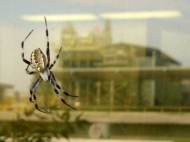Future applications of synthetic silk and challenges that remain
 Natural silk, fibers made by spiders and silkworms, is a material that is tougher than kevlar or steel, yet remarkably flexible. In recent years, researchers have worked to gain a better understanding of what silk is and how it’s made, with the goal of being able to consistently replicate and enhance its production synthetically. Aside the usage in clothing, new kinds of silk could be used in various other applications.
Natural silk, fibers made by spiders and silkworms, is a material that is tougher than kevlar or steel, yet remarkably flexible. In recent years, researchers have worked to gain a better understanding of what silk is and how it’s made, with the goal of being able to consistently replicate and enhance its production synthetically. Aside the usage in clothing, new kinds of silk could be used in various other applications.
Fiorenzo G. Omenetto and David L. Kaplan, researchers from the Department of Biomedical Engineering in Tufts University School of Engineering, reviewed the state of silk research, the challenges that remain, and why synthetic silk production is so appealing in the July 30 edition of the journal Science. According to them, the first challenge is to figure out how to reverse engineer the spider’s silk, essentially turning back the clock to an earlier step in the process when the silk is just a soup of chemicals.
Research has established what those proteins are, and they have determined that the properties of silk can vary a great deal depending on factors such as the outside temperature, how fast the silk is spun, and the exact type of silk created. But no one knows how exactly the spiders and silk worms actually make silk. Scientists have determined they don’t secrete the stuff, but instead pull it out of special glands in very specific ways. Spiders, for example, pull it with their legs, while silkworms perform a “figure eight” dance with their heads to create the silk threads.
When the scientists try to store silk proteins in the lab, they find they must do so under exacting conditions, or material will quickly begin to crystallize. Nature’s silk makers, on the other hand, don’t seem to have this problem. They can store the raw silk materials internally at a variety of temperatures for days and even weeks without encountering the crystallization problem, and at this point in time, researchers aren’t sure how they do it.
Since the researchers envision silk being used to make a broad range of products, including implantable electrodes, medical sutures, ligament and bone tissue repairs, and flexible electronic displays, one goal of their research is to find a way to genetically engineer other organisms to produce custom-designed silk proteins that could then be used to produce synthetic silk for specific purposes on a large scale.
The potential need for larger application of silk has led to genetically modified mushrooms, bacteria and even goats that are able to produce silk protein, yet none of the actual silk produced from these modified organisms matches the qualities of the stuff produced by spiders and silk worms. Once these issues are overcome, the researchers expect that plants could be modified to produce silk as a crop, like cotton is harvested today.









Leave your response!